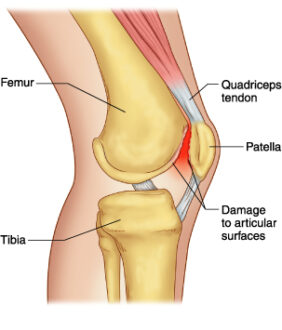Read about Patellofemoral Pain Syndrome (PFPS) Symptoms and Treatment with Surgery, Physical therapy.
Patellofemoral pain syndrome is a broad term used to describe pain in the front of the knee and around the patella, or kneecap. It is also known as runner’s kneeorjumper’s kneebecause it is common in people who participate in sportsparticularly females and young adultsbut patellofemoral pain syndrome can occur in nonathleticas well.
The pain and stiffness it causes can make it difficult to climb stairs, kneel down and perform other everyday activities.Many things may contribute to the development of patellofemoral pain syndrome.
Following are the major factors contributing:
- Problems with the alignment of the kneecap
- Overuse from vigorous athletics
- Over training are often significant factor
- Injury
- Excess weight
- Changes under the kneecap,
- Mal-alignment between the joint surfaces
- Excessive knee valgus (ie, increased Q-angle) that might be resulting in increased lateral forces
- Quadriceps contractures causing production of excessive leverage forces on the patellofemoral joint surface
- Wearing down, roughening, or softening of the cartilage under the kneecap
The medical cause of PFPS is thought to be increased pressure on the patellofemoral joint. There are several theorized mechanisms relating to how this increased pressure occurs:
- Increased levels of physical activity
- Mal-alignment of the patella as it moves through the femoral groove that is known as patellar tracking disorder
- Quadriceps muscle imbalance
- Tight anatomical structures, e.g. retinaculum or Iliotibial band

Patellofemoral Pain Syndrome Symptoms and Treatment with Surgery, Physical therapy
Let’s review Patellofemoral Pain Syndrome Symptoms and Treatment with Surgery, Physical therapy.
Symptoms
The most common symptom of patellofemoral pain syndrome is a dull, aching pain in the front of the knee. This painusually begins gradually and is frequently activity related. It may be present in one or both knees. Other common symptoms include:
- Pain during exercise and activities that repeatedly bend the knee, such as climbing stairs, running, jumping, or squatting
- Pain after sitting for a long period of time with your knees bent, such as one does in a movie theater or when riding on an airplane
- Pain related to a change in activity level or intensity, playing surface, or equipment
- Popping or crackling sounds in your knee when climbing stairs or when standing up after prolonged sitting
- Occasional knee buckling, in which the knee suddenly and unexpectedly gives way and does not support your body weight
- Sometimes swelling around the patella
Treatment
Treatment plan of physical therapy consists of following procedures:
Activity Changes
Stop doing the activities that make your knee hurt until your pain is resolved. This may mean changing your training routine or switching to low-impact activities that will place less stress on your knee joint. Biking and swimming are good low-impact options. If you are overweight, losing weight will also help to reduce pressure on your knee.
The RICE Method
RICE stands for rest, ice, compression, and elevation. It is described as
Rest: Avoid putting weight on the painful knee.
Ice: Use cold packs for 20 minutes at a time, several times a day. Do not apply ice directly on skin.
Compression:To prevent additional swelling, lightly wrap the knee in an elastic bandage, leaving a hole in the area of the kneecap. Make sure that the bandage fits snugly and does not cause additional pain.
Elevation:As often as possible, rest with your knee raised up higher than your heart.
Exercises
The basic exercise principles for management of patellofemoral syndrome (PFS) are
- Restoring muscle balance within the quadriceps group
- Improving range of motion
- Restricting the offending physical activity
Main exercises include:
- Quadriceps strengthening traditionally is performed while the knee is flexed 0-30°
- Stretching of the quadriceps should be of long duration (20-30 seconds) and performed with low force
- Aerobic exercises
- Isometrics
Ice Therapy
Ice packs frequently are used to decrease pain and inflammation associated with PFS, especially after completing the exercises. Other modalities that may be useful and commonly are incorporated into physical therapy include electrical stimulation and biofeedback.
Taping
Patellar taping techniques are used in patients with Patello Femoral Syndrome to reduce the friction on the patella.
Foot Orthoses
Proper footwear also is important for individuals with PFS. The physical therapist can evaluate the patient’s biomechanics and recommend proper shoes and orthoses, which in turn can lessen knee pain.
Knee Braces
Soft knee braces may also be of benefit to patients with PFS. Bracing involves control of the tracking position of the patella and restriction of full knee flexion.
Surgery
There are several surgeries for patellofemoral pain depending on what surgeon needs to do and whether there are other associated injuries present or not. These include arthroscopic surgery as well as more complex procedures.
Arthroscopic Surgery
With the arthroscope in the affected knee, the surgeon can see exactly how the kneecap tracks in its groove and identify any instability or tendency to dislocate. Surgeon also can determine whether some of the tendons and structures that are attached to kneecap are too tight, too loose or torn.
Once the problem is identified, the appropriate procedures can be performed. These may include tightening, releasing or a combination of procedures that will ultimately allow the kneecap to track properly.
Lateral Release
A lateral release to treat patellofemoral pain syndrome is performed when the fibrous bands (retinaculum) attached to the outside part of your kneecap are too tight and pull the kneecap out of position. Surgeons cut this tight structure, allowing the kneecap to move back into its track.
If patella is tracking too far laterally, the medial tissues may be tightened in addition to a lateral release to help with patella tracking. In some cases, the area where the patella tendon inserts may be adjusted to improve the tracking of the kneecap.
 Health & Care Information
Health & Care Information 

